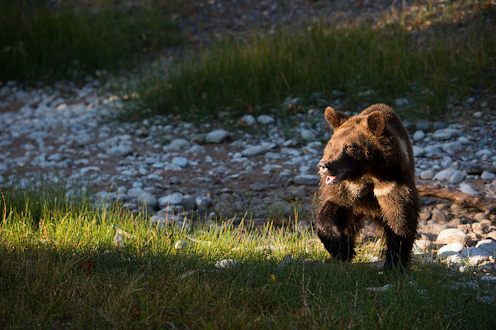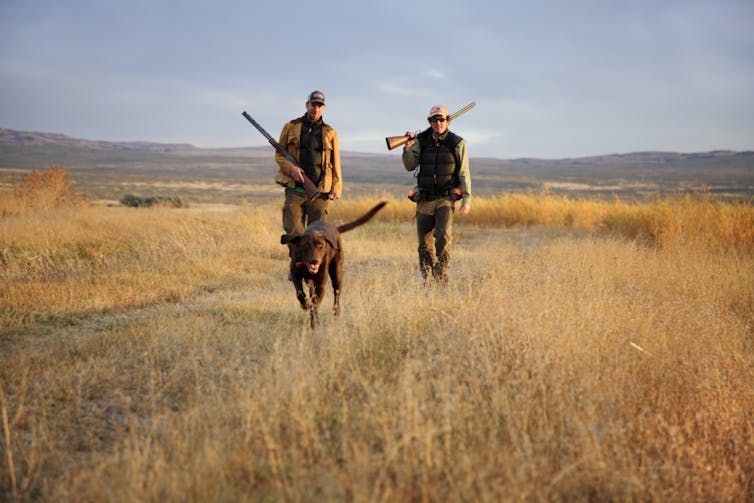Grizzly bear conservation is as much about human relationships as it is the animals
Whether people are hunters can have a big effect.

Montanans know spring has officially arrived when grizzly bears emerge from their dens. But unlike the bears, the contentious debate over their future never hibernates. New research from my lab reveals how people’s social identities and the dynamics between social groups may play a larger role in these debates than even the animals themselves.
Social scientists like me work to understand the human dimensions behind wildlife conservation and management. There’s a cliché among wildlife biologists that wildlife management is really people management, and they’re right. My research seeks to understand the psychological and social factors that underlie pressing environmental challenges. It is from this perspective that my team sought to understand how Montanans think about grizzly bears.
To list or delist, that is the question
In 1975, the grizzly bear was listed as threatened under the Endangered Species Act following decades of extermination efforts and habitat loss that severely constrained their range. At that time, there were 700-800 grizzly bears in the lower 48 states, down from a historic 50,000. Today, there are about 2,000 grizzly bears in this area, and sometime in 2024 the U.S. Fish and Wildlife Service will decide whether to maintain their protected status or begin the delisting process.
Listed species are managed by the federal government until they have recovered and management responsibility can return to the states. While listed, federal law prevents hunting of the animal and destruction of grizzly bear habitat. If the animal is delisted, some states intend to implement a grizzly bear hunting season.
People on both sides of the delisting debate often use logic to try to convince others that their position is right. Proponents of delisting say that hunting grizzly bears can help reduce conflict between grizzly bears and humans. Opponents of delisting counter that state agencies cannot be trusted to responsibly manage grizzly bears.
But debates over wildlife might be more complex than these arguments imply.
Identity over facts
Humans have survived because of our evolved ability to cooperate. As a result, human brains are hardwired to favor people who are part of their social groups, even when those groups are randomly assigned and the group members are anonymous.
Humans perceive reality through the lens of their social identities. People are more likely to see a foul committed by a rival sports team than one committed by the team they’re rooting for. When randomly assigned to be part of a group, people will even overlook subconscious racial biases to favor their fellow group members.
Leaders can leverage social identities to inspire cooperation and collective action. For example, during the COVID-19 pandemic, people with strong national identities were more likely to physically distance and support public health policies.
But the forces of social identity have a dark side, too. For example, when people think that another “out-group” is threatening their group, they tend to assume members of the other group hold more extreme positions than they really do. Polarization between groups can worsen when people convince themselves that their group’s positions are inherently right and the other group’s are wrong. In extreme instances, group members can use these beliefs to justify immoral treatment of out-group members.
Empathy reserved for in-group members
These group dynamics help explain people’s attitudes toward grizzly bears in Montana. Although property damage from grizzly bears is extremely rare, affecting far less than 1% of Montanans each year, grizzly bears have been known to break into garages to access food, prey on free-range livestock and sometimes even maul or kill people.
People who hunt tend to have more negative experiences with grizzly bears than nonhunters – usually because hunters are more often living near and moving through grizzly bear habitat.

In a large survey of Montana residents, my team found that one of the most important factors associated with negative attitudes toward grizzly bears was whether someone had heard stories of grizzly bears causing other people property damage. We called this “vicarious property damage.” These negative feelings toward grizzly bears are highly correlated with the belief that there are too many grizzly bears in Montana already.
But we also found an interesting wrinkle in the data. Although hunters extended empathy to other hunters whose properties had been damaged by grizzly bears, nonhunters didn’t show the same courtesy. Because property damage from grizzly bears was far more likely to affect hunters, only other hunters were able to put themselves in their shoes. They felt as though other hunters’ experiences may as well have happened to them, and their attitudes toward grizzly bears were more negative as a result.
For nonhunters, hearing stories about grizzly bears causing damage to hunters’ property did not affect their attitudes toward the animals.
Identity-informed conservation
Recognizing that social identities can play a major role in wildlife conservation debates helps untangle and perhaps prevent some of the conflict. For those wishing to build consensus, there are many psychology-informed strategies for improving relationships between groups.
For example, conversations between members of different groups can help people realize they have shared values. Hearing about a member of your group helping a member of another group can inspire people to extend empathy to out-group members.
Conservation groups and wildlife managers should take care when developing interventions based on social identity to prevent them from backfiring when applied to wildlife conservation issues. Bringing up social identities can sometimes cause unintended division. For example, partisan politics can unnecessarily divide people on environmental issues.
Wildlife professionals can reach their audience more effectively by matching their message and messengers to the social identities of their audience. Some conservation groups have seen success uniting community members who might otherwise be divided around a shared identity associated with their love of a particular place. The conservation group Swan Valley Connections has used this strategy in Montana’s Swan Valley to reduce conflict between grizzly bears and local residents.
Group dynamics can foster cooperation or create division, and the debate over grizzly bear management in Montana is no exception. Who people are and who they care about drives their reactions to this large carnivore. Grizzly bear conservation efforts that unite people around shared identities are far more likely to succeed than those that remind them of their divisions.
Alexander L. Metcalf has received funding from the National Fish and Wildlife Foundation, the National Science Foundation, the Richard King Mellon Foundation, the Pennsylvania Department of Conservation and Natural Resources, the Montana Department of Fish, Wildlife and Parks, the US Geological Survey, and the US Department of Agriculture Forest Service. Dr. Metcalf is an advisor to the Swan Valley Connections board of directors.
Read These Next
What’s at stake in Trump’s executive order aiming to curb state-level AI regulation
In the absence of comprehensive federal AI regulation, states have stepped in. The Trump administration,…
The Bible says little about Jesus’ childhood – but that didn’t stop medieval Christians from enjoyin
Legends about Jesus’ early years that circulated in medieval Europe often drew on apocryphal texts.
Sleep problems and depression can be a vicious cycle, especially during pregnancy − here’s why it’s
Inadequate sleep can have negative downstream effects on everyday cognitive functioning and mental health,…





